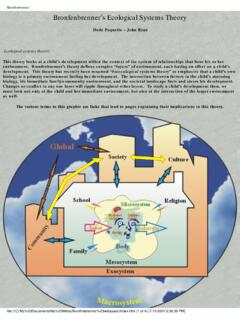Transcription of Design Thinking vs. Systems Thinking for Engineering ...
1 ICED17 MANUSCRIPT FOR 21ST INTERNATIONAL CONFERENCE ON Engineering Design 21-25 AUGUST 2017, THE UNIVERSITY OF BRITISH COLUMBIA, VANCOUVER, CANADA Design Thinking vs. Systems Thinking for Engineering Design : What s the Difference? Melissa T. Greene1 Richard Gonzalez1 Panos Y. Papalambros1 Anna-Maria McGowan2 Abstract: Design Thinking (DT) and Engineering Systems Thinking (EST) are two complementary approaches to understanding cognition, organization, and other non-technical factors that influence the Design and performance of Engineering Systems . Until relatively recently, these two concepts have been explored in isolation from one another; Design Thinking methods have been applied to industrial Design and product development, while Engineering Systems Thinking is used in professional Systems Engineering practice and large-scale, complex Systems Design . This work seeks to explore the relationship between these two concepts, comparing their historical development, values, applications, and methods.
2 The primary contribution of the work is a set of four concept models that depict plausible relationships between Design Thinking and Systems Thinking for Engineering Design . Keywords: Design cognition, Design theory , Design methodology, Systems Engineering (SE), Multi- /Cross- / Trans-disciplinary processes 1 University of Michigan, Ann Arbor, MI, USA 2 NASA Langley Research Center, Hampton, VA, USA ICED17 1 INTRODUCTION Conceptual Design of products and Systems is a difficult process, during which cognitive, social, and technical challenges abound. To address these, formal Design Engineering methodologies offer theory , process models, and best practices, as well as insights about psychological processes and social behaviours that comprise "designerly ways of knowing (Cross, 1982)." Two such approaches, Design Thinking and Systems Thinking , have emerged in parallel as methods for tackling these "wicked" Design problems in diverse settings (Rittel and Webber, 1973; Checkland, 1981; Clarke, 2000).
3 Design Thinking and Systems Thinking frameworks are useful for anticipating and addressing emergent features of products, Systems , and organizations (Plattner et al., 2014; McGowan, 2014; Viswanathan and Linsey, 2014; Davidz and Nightingale, 2008), and have additional applications in Engineering Design (Forrester, 1961; Frank, 2000; Dinar et al., 2015; Watson et al., 2014; McGowan et al., 2017), management and organization (Senge, 1990; Checkland, 1981, 1999), pedagogy (Dym et al., 2005; Lammi and Becker, 2013), and other contexts. While domain independence is considered an advantage of the Design Thinking and Systems Thinking frameworks, divergent definitions and approaches have created an ambiguous literature. At its worst, this situation has led to the dismissal of these concepts as "buzzwords," devaluing the empirical evidence that supports them (Patel and Mehta, 2016; Dinar et al.)
4 , 2015; Shah et al. 2012; Jaradat, 2015). Additional work is necessary to address this criticism, and to integrate and strengthen the existing body of knowledge. Until recently, Design Thinking and Systems Thinking have been explored mostly in isolation from one another. Systems Thinking is sometimes described as a component of Design Thinking (Long, 2012), sometimes as separate but related to Design Thinking (Patel and Mehta, 2016), and is sometimes not described alongside Design Thinking at all. Likewise, references to Design Thinking research are not often found in Systems Engineering research on Systems Thinking or Systems Design . Understanding how system designers think is key to advancing Systems Engineering methods, tools, and outcomes (Griffin, 2010; Watson et al., 2014). Design Engineering researchers in academia have successfully adapted formal cognitive science approaches to study designer Thinking (Dinar et al.
5 , 2015). Systems Engineering researchers in industry and government have broadly identified skills, attitudes, and behaviours necessary for complex Systems Design (Frank, 2006; Williams and Derro, 2008; Davidz et al., 2005; Rhodes et al., 2008), but existing cognitive approaches are limited (Greene and Papalambros, 2016). Studying the relationship between designer Thinking and Systems Thinking paradigms could be useful for addressing this gap, and for identifying other areas in which one methodology might be improved by the knowledge of the other. This work makes a first attempt at comparing research perspectives on Engineering Design Thinking (DT) and Engineering Systems Thinking (EST). Its purpose is neither to provide a complete analysis of the literature nor to propose a new definition of either concept. Rather, it is intended to serve as a primer on the history, values, applications, and methods of each approach and to relate them to one another.
6 Comparing the historical context and values underlying each approach is useful for explaining why Design Thinking and Engineering Systems Thinking evolved independently into what they are today. Exploring contemporary applications and methods is useful for identifying opportunities to share knowledge and tools between communities in future research efforts. The rest of the work is structured as follows to achieve these objectives. Sections 2 & 3 provide a brief introduction to relevant literature from the Design Engineering and Systems Engineering communities. The literature review is organized by high-level themes history, values, applications, and methods that recur throughout. Section 4 suggests several different ways to compare Design Thinking and Systems Thinking using these themes, represented by "concept models" that visually position DT and EST themes relative to one another.
7 The themes and concept models proposed are coarse, and the authors do not suggest any single "correct" model for the relationship between DT and EST. Rather, these models represent several plausible theories about the relationship between Design Thinking and Systems Thinking methodologies, and are meant to encourage additional discourse and collaboration between the Design and Systems Engineering communities. ICED17 2 Design Thinking & THE SCIENCE OF Design A brief history of Design Thinking research Rapid technological development throughout the twentieth century generated a need for formal academic study of "the science of Design (Simon, 1969)." Two important periods in the modern history of Design science are identified by Cross (1982). The first, the " Design products movement" of the 1920s, sought to "produce works of art and Design based on objectivity and rationality;" that is, on the values of science.
8 The second, the " Design methods movement" of the 1960s, sought to establish Design processes in addition to the products of Design based on similar scientific principles. Despite some backlash against Design methodology in the 1970s, the tradition continued to flourish in Engineering and industrial Design , and several prominent academic journals for Design research, theory , and methodology emerged during the 1980s and 1990s. Design methodology is defined by Cross (1982) as "the study of the principles, practices, and procedures of Design " and "includes the study of how designers work and think." Over the past several decades, Engineering researchers have successfully leveraged cognitive and social science approaches to study how designers think through Engineering Design problems, exploring a breadth of topics including creativity, ideation in early conceptual Design , the role of analogies in creative problem solving, differences between novices and experts, and strategies for overcoming fixation and mental blocking.
9 Verbal protocol analysis, cognitive ethnography, controlled laboratory experiments, and other formal methods from cognitive science have been rigorously applied to the study of designer Thinking in Engineering (Dinar et al., 2015; Shah et al., 2012). Results of these studies and others suggest that Design Thinking approaches use solution-based methods to explore human-centred values throughout the Engineering Design process. This finding is reflected in many applications of Design Thinking : prototyping, a solution-based method, is often cited as a useful way to encourage inspiration, ideation, and organizational learning, all human-centred values (Brown, 2009; McGowan et al., 2017). Specific applications and methods for Design Thinking will be briefly described in the following sections. Applications of Design Thinking research Many applications of the Design Thinking framework exist in the literature and in practice.
10 Examples include Herbert Simon's Design Thinking process (1969), which suggests seven stages of Design Thinking for product Design , including defining the problem, researching, ideating, prototyping, choosing a solution, implementing the solution, and learning. Plattner, Meinel and Leifer (2011) propose a five-step version of the Design Thinking process that includes redefining the problem, need finding and benchmarking, ideating, building, and testing. International Design and consulting firm IDEO applies a four-phase process that includes gathering inspiration, generating ideas, making ideas tangible, and sharing your story (Brown, 2009). While each interpretation differs slightly from the others, important foundational values of Design Thinking persist. First, Design Thinking is solution-based, and most Design Thinking methods include prototyping and iteration phases.
















